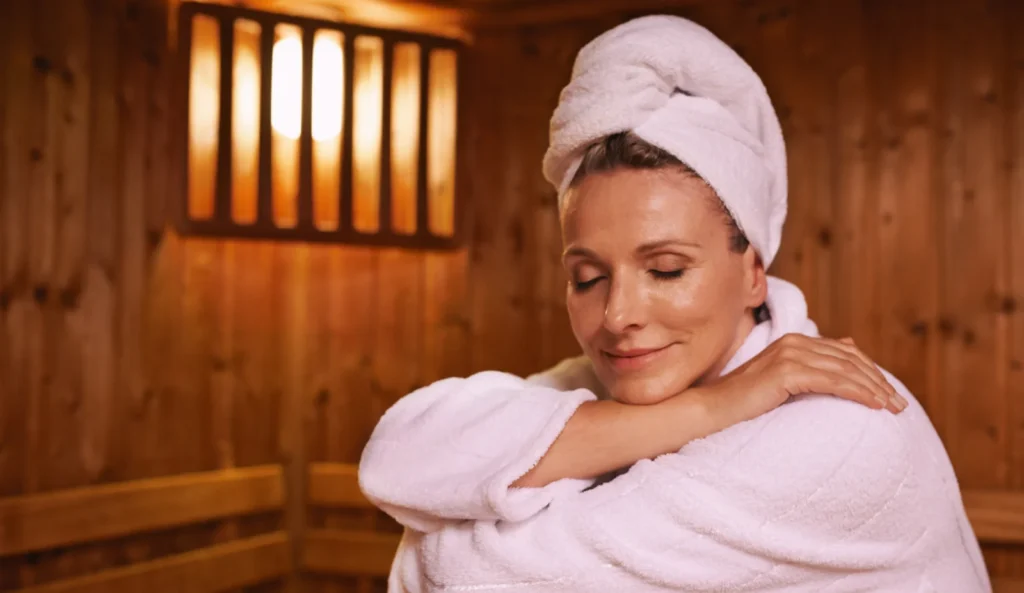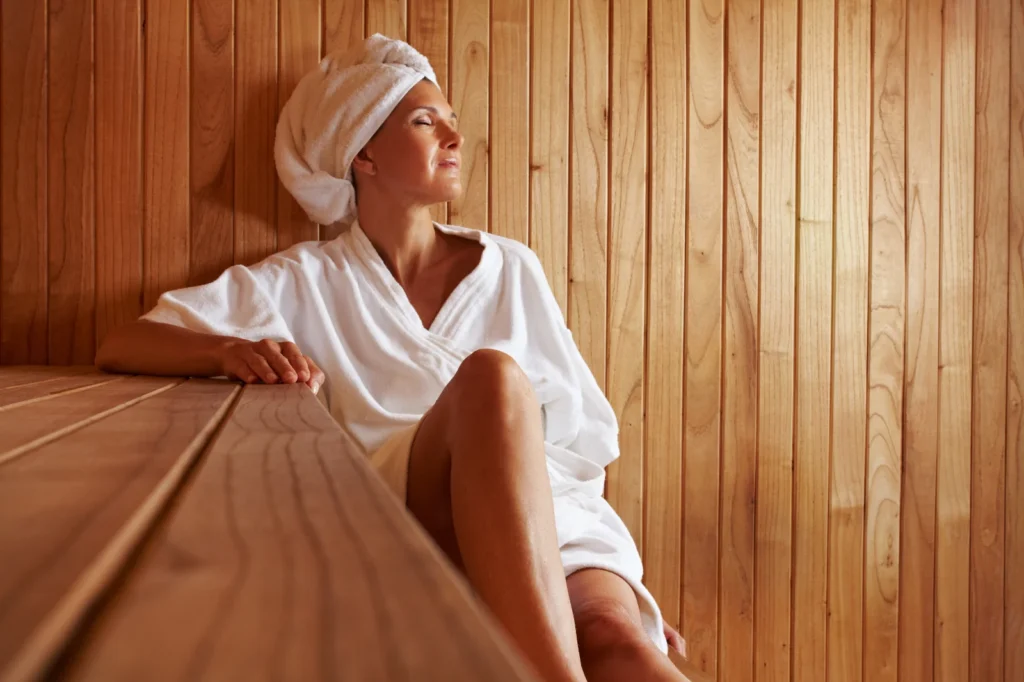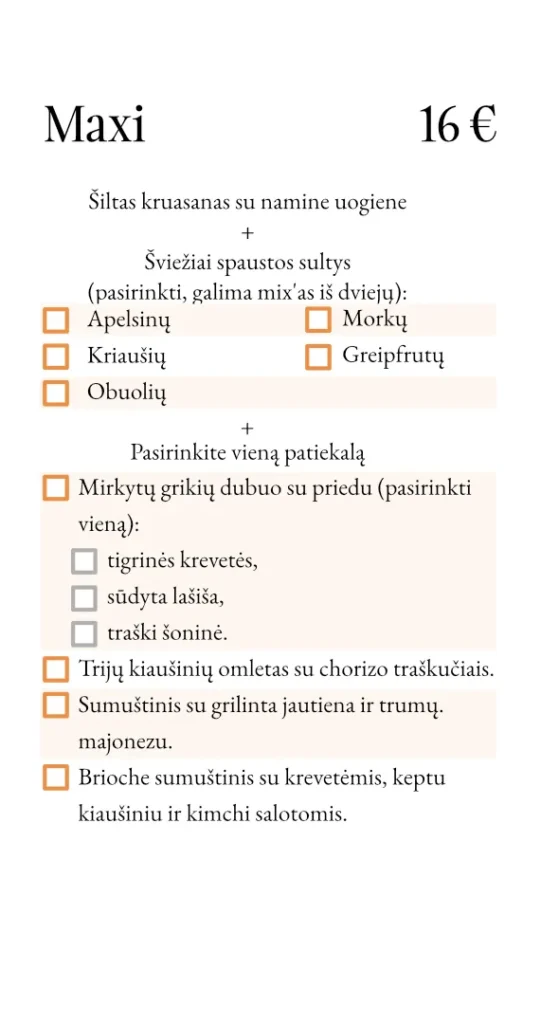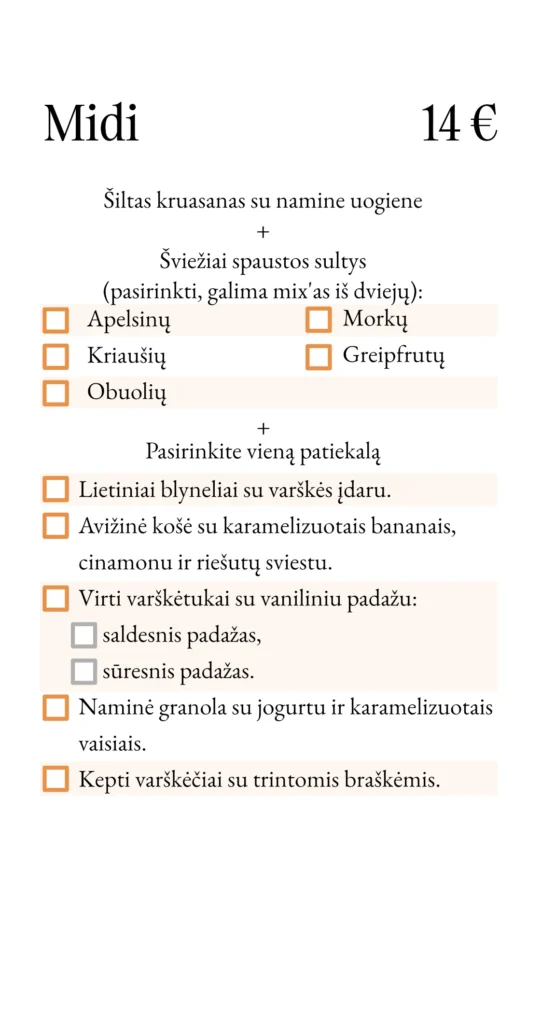Sauna - TOP 26 tips
Sauna - 26 tips for a perfect visit
Spending time in a sauna is a relaxing way to improve your health and general well-being. Many people know that a hot sauna boosts immunity, improves blood circulation and reduces stress. However, it is important to take a sauna the right way. To get the most out of your sauna, it's important to know which sauna to choose, what to do before and after and what mistakes to avoid. Tips for a safe and effective visit:
Types and types of saunas - which one for you?
There are many different types of baths, each offering a different experience and benefits for the body. If you like a sauna that is extremely hot and extremely relaxing, a Finnish sauna is the right choice. It has high temperatures of 70-100 °C and extremely low humidity levels (as low as 5-20 %). This allows the body to heat up quickly and sweating to become very intense.

If you are not a fan of high heat, but want to relax slowly and enjoy the process, we recommend the Russian steam bath. These saunas have lower temperatures (around 40-70 °C) but higher humidity levels (around 60-80 %). The heat is therefore distributed more slowly in this type of sauna and the body relaxes easily.
People who cannot tolerate high temperatures or have cardiovascular problems can try the currently popular infrared sauna. Such a sauna It is not heated by hot air, but by infrared rays, which heat the body directly. The temperature in such a sauna ranges from 40 to 60 °C and there is almost no humidity, making it ideal for those whose bodies cannot tolerate high temperatures.
Another sauna where you won't feel the scorching heat, but you'll be warm and comfortable is Turkish hammam. This sauna differs from others not only in its structure but also in its temperature. The temperature in the Hammam is usually below 50 °C, but the humidity level is high, reaching almost 100 % in these saunas. So you won't feel very hot in such a sauna. Because of the relatively low temperature inside the room, the hammam is often used for beauty treatments such as skin scrubs or massages.
Each type of sauna has its own unique features. When choosing a sauna, it's important to consider your needs: how you tolerate heat, how your body reacts to humidity and what you want from a sauna visit - a quick and effective heating up of your body, or maybe you want a slower, deeper relaxation.

3 tips BEFORE visiting a sauna:
To get the most out of your sauna and truly relax, it is important to prepare properly. Have you ever heard that this can be influenced by the time you choose to take a sauna or, for example, by the food you eat before you visit the sauna? Here's what you should know and do before you visit the sauna:
- Decide what effect you want and use that as a guide Choose the right time of day for your sauna treatments. If you want to boost your energy levels, prepare for an active day and feel invigorated, visit the sauna in the morning. Morning sauna treatments stimulate blood circulation, increase alertness and invigorate. If your goal is to relax, de-stress and de-stress - an evening sauna will calm your nervous system, reduce tension and improve the quality of your sleep. Find out how to choose the right time to visit a sauna here.
- Eating the wrong food before a sauna will prevent you from relaxing properly. Heavy, fatty or extremely salty foods can cause drowsiness, swelling or even nausea during bathing. For this reason, do not eat fatty or fast food for at least 2 hours before your sauna visit and avoid sweets. We lose a lot of fluids during bathing, and caffeine and alcohol can further promote dehydration, so we particularly advise against these fluids before a sauna.
- Sport and sauna - good or bad? Research showsthat sauna increases heart rate, muscle tension and sweating in a similar way to a moderate-intensity workout. So if you do an intense workout and then go to the sauna, your body will be under double strain. As a result, you are more likely to feel tired than relaxed when you go to the sauna after an intense sport. So if you plan to exercise, choose a low-intensity workout and wait at least 30-60 minutes after the sport. It is a good idea to avoid working out before the sauna altogether. However, light exercise, such as stretching or yoga, can be helpful. These are activities that help to relax the muscles, lightly warm up and prepare the body for the hot sauna.
Sauna: how to heat up to get the full benefits
Now that you're familiar with the basic tips on how to behave before you go to the sauna, it's time for the most important part - the actual bathing process. How do you go about the sauna to get the most out of it? How long to stay in the sauna and what tells you when it's time to leave? Answering these important questions will ensure that you have a safe and effective sauna.
6 important tips that few people know
- Allow your body to warm up after taking it easy. The temperature in the sauna varies depending on the altitude - the higher you go, the hotter it is. If you sit on the top bench as soon as you enter, your body will experience a sudden heat shock, which can cause dizziness or discomfort. Give your body time to warm up after an easy one, so sit on the lower bench first and gradually work your way up.
- Sitting still is not the best option. Many people tend to sit still in the sauna. However, a light body massage or even a simple rubbing of the hands and feet improves circulation and helps the body remove toxins.
- If the sauna is too hot for you, you can lie down. If you feel that your face or head is burning too much, but you don't want to leave yet, try lying down or lowering your head or resting your elbows on your knees. As the hot air rises upwards, lowering your head can help you feel better.
- Is it bad if you don't sweat in the sauna? Some people start sweating in the sauna after a longer period of time, or sweat very little at all. This is a sign that the body is not used to heat therapy. In these cases, you can help your body get used to the heat by drinking a glass of warm water before the sauna or by doing a short warm-up, such as a few squats or stretching exercises.
- Proper breathing determines the effectiveness of the bath. Most people breathe instinctively in the sauna, but consciously controlling your breathing can help you achieve deeper relaxation. Slow, deep breathing through the nose helps the body adapt to the heat. Another tip if the sauna is getting too hot and you don't want to leave yet - breathe through your mouth.
- Don't wet your whole body before a sauna. Many people take a shower before a sauna to get their whole body wet, but this can interfere with sweating. The layer of water on the skin acts as a barrier and reduces the skin's ability to sweat quickly and therefore remove toxins from the body. If you want a more effective sauna, wet only your feet and face and leave your body dry.
Mistakes to avoid in the sauna
It is a common myth that iced water or other cold drinks are good for bathing. But it's the sudden temperature contrasts that really stress the body. We assure you that drinking fragrant, warm tea or at least lukewarm water in the sauna will make you feel much better.
While sauna offers many health benefits - improving circulation, relaxation and immunity - some mistakes can reduce its benefits or even do more harm than good. First of all, avoid walking backwards and forwards. If you keep going in and out of the sauna, your body doesn't have time to adjust and warm up properly. It is much more beneficial to stay in the sauna for a while, let it warm up your body and then take it easy to cool down.
It is worth paying attention to how you sit in the sauna. Sitting upright, with your head close to the ceiling and your feet on the bottom of the bed, exposes your body to a temperature difference that can cause headaches or dizziness for some. So it is best to sit with your legs and body at the same height (stretch your legs out on a bench) or you can lie down.

Sauna does not require endurance. Do not try to stay in the sauna for as long as possible, thinking that this will give you the maximum sauna effect. Excessive heat and dehydration will not enhance the effects of the sauna, but will instead exhaust the body. If you feel shortness of breath, weakness, dizziness or increased heart rate or blood pressure, these are signals for you to get out of the sauna.
The following system can help you understand and navigate how long to stay in the sauna: visit the sauna 2 to 4 times per visit, and let each visit last between 5 and 15 minutes. The first visit to the sauna is usually the shortest - 5 to 10 minutes - to allow your body to get used to the heat. The second and third visits can last 10-15 minutes, depending on how you feel. If you go a fourth time, your body may be a little tired, so keep it short. The most important thing is not to push yourself, not to wait until you feel weak and to leave the sauna before you feel any discomfort. After all, a sauna should be enjoyable and relaxing, not a test of your well-being. More tips here.
Bathroom etiquette: what do you need to know?
Bathing is a kind of ritual experience that comes with rules. In order to make the bathing process enjoyable for both you and the people around you, you should follow a few principles of appropriate behaviour.
- Cleanliness. Take a shower before going to the sauna. First of all, this is important for hygiene reasons. But it's also good for the bathing process itself - clean skin will help remove toxins faster, so "will not interfere" cosmetics and fragrances.
- A towel is essential. In public baths, you are usually required to sit or lie on your own towel for hygiene reasons. We recommend that you do this even if the sauna is private and you are with people you are close to, to maintain general order and hygiene.
- Don't make noise. The sauna is a place of relaxation, so conversations should be avoided or kept very quiet.
- Avoid strong fragrances. Do not use lotions, oils or deodorants with strong fragrances in or before the sauna. Heat activates these scents and they can become too strong and irritating for others.
- Consult others before pouring water on stones. Some people like a dry and hot sauna, others a wetter one. There are times when people in communal saunas decide to create a more humid environment and, without warning the other people in the sauna, pour water over the hot sauna stones. Please be courteous and respectful of other visitors who may be uncomfortable with a sudden burst of steam.
- Do not wipe sweat with your hands. If you sweat profusely, use a towel to wipe the sweat away, and do not rub your body with your hands - this is important for both hygiene and general atmosphere.
A few simple rules of common etiquette that will make you feel comfortable and create a pleasant atmosphere for those around you. The sauna is a place for relaxation and recreation, so respect for yourself and others is very important.
After the sauna: how to finish the sauna properly?
A sauna doesn't end when you leave the sauna - a proper routine of cooling down, hydration and relaxation helps your body get the most out of the sauna. How to refresh, what to drink or eat and what to do to feel even better after a sauna?
How do I cool my body down after a sauna?
First of all, don't rush to take a cold shower or jump into a cool pool or cold body of water after your last visit to the sauna. Stand or sit quietly in a cooler room, or lie down for 10 to 15 minutes - let your body cool down naturally, after an easy cool-down. You should also drink more fluids, so herbal tea or non-cold water is ideal after a sauna. Try to breathe slowly and deeply as you cool down - this will help your body recover from the heat and calm your heart rate.
How can I avoid dehydration after a sauna?
A sauna promotes sweating, so we come out of it with a lot of fluid loss. It is important to restore your fluid balance after a sauna to maintain your well-being and get the most out of your sauna.
- It is recommended to drink at least 0.5-1 litre of water after a sauna. You can drink lukewarm water or herbal tea. Avoid coffee, fizzy drinks and alcohol - they cause even more dehydration.
- Bathing helps remove dead skin cells and opens up pores, making your skin softer but... more vulnerable. To maintain your skin's elasticity, nourish your skin after a sauna natural oils or a light moisturiser.
Sweat not only deprives us of moisture, but also of minerals such as sodium, potassium and magnesium. So an additional tip is to make sure you're getting the nutrients you need. You can drink water with lemon. Bananas, nuts or dried fruit are good for snacks as they are rich in potassium and magnesium. Vegetable broth is also an excellent micronutrient restorer.

Can I eat immediately after a sauna?
Don't rush to eat immediately after your bath, Wait at least 30 minutes to allow your body to recover from the heat and not overload your digestive system. Afterwards, nutritious, easily absorbed food that does not burden the body is suitable. This can include fresh fruit and vegetables, which are not only rich in beneficial substances, but also in fluids. A variety of seeds and nuts are ideal for a light snack. Wholemeal bread, oats or brown rice are also great choices as they restore energy. As before the sauna, heavy, fatty meals or very sweet snacks should be avoided after the sauna.
Can I go to bed after a sauna?
While a sauna is very relaxing and reduces stress levels, it also raises body temperature, so it is important to let your body cool down a little before going to bed. Wait 30-60 minutes after the sauna, during which time your body temperature will return to normal, and then you can go back to rest.
How often can I visit the sauna?
There are many benefits of sauna, but it is important to keep it in balance and not overdo it or harm your health. We would like to point out that everyone's body is different, so, How often you can visit the sauna depends on your health, lifestyle and sauna habits. It is generally recommended to visit the sauna 2-3 times a week. This regularity gives the body enough time to recover from each visit, but at the same time to reap the benefits of the sauna all over again.
The following symptoms betray too frequent visits to the sauna, Like tiredness, headaches and dry skin. You may also notice that you don't feel as relaxed or happy on your last visits. Too many visits to the sauna can also disrupt your sleep rhythm.
Questions? Contact us!
Fill in the form. This is the quickest way to make a booking request.
Call us. We will advise and help you
+370 630 08558
Contact us at [email protected]



